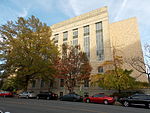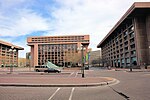Institute of Education Sciences
2002 establishments in the United StatesEducational researchEducational testing and assessment organizationsGovernment agencies established in 2002United States Department of Education agencies ... and 1 more
Use mdy dates from May 2018

The Institute of Education Sciences (IES) is the independent, non-partisan statistics, research, and evaluation arm of the U.S. Department of Education. IES' stated mission is to provide scientific evidence on which to ground education practice and policy and to share this information in formats that are useful and accessible to educators, parents, policymakers, researchers, and the public. It was created as part of the Education Sciences Reform Act of 2002. The first director of IES was Grover Whitehurst, who was appointed in November 2002 and served for six years. Mark Schneider is currently the Director of IES.
Excerpt from the Wikipedia article Institute of Education Sciences (License: CC BY-SA 3.0, Authors, Images).Institute of Education Sciences
12th Street Southwest, Washington
Geographical coordinates (GPS) Address Nearby Places Show on map
Geographical coordinates (GPS)
| Latitude | Longitude |
|---|---|
| N 38.883333 ° | E -77.0275 ° |
Address
Potomac Center South
12th Street Southwest
20228 Washington
District of Columbia, United States
Open on Google Maps








